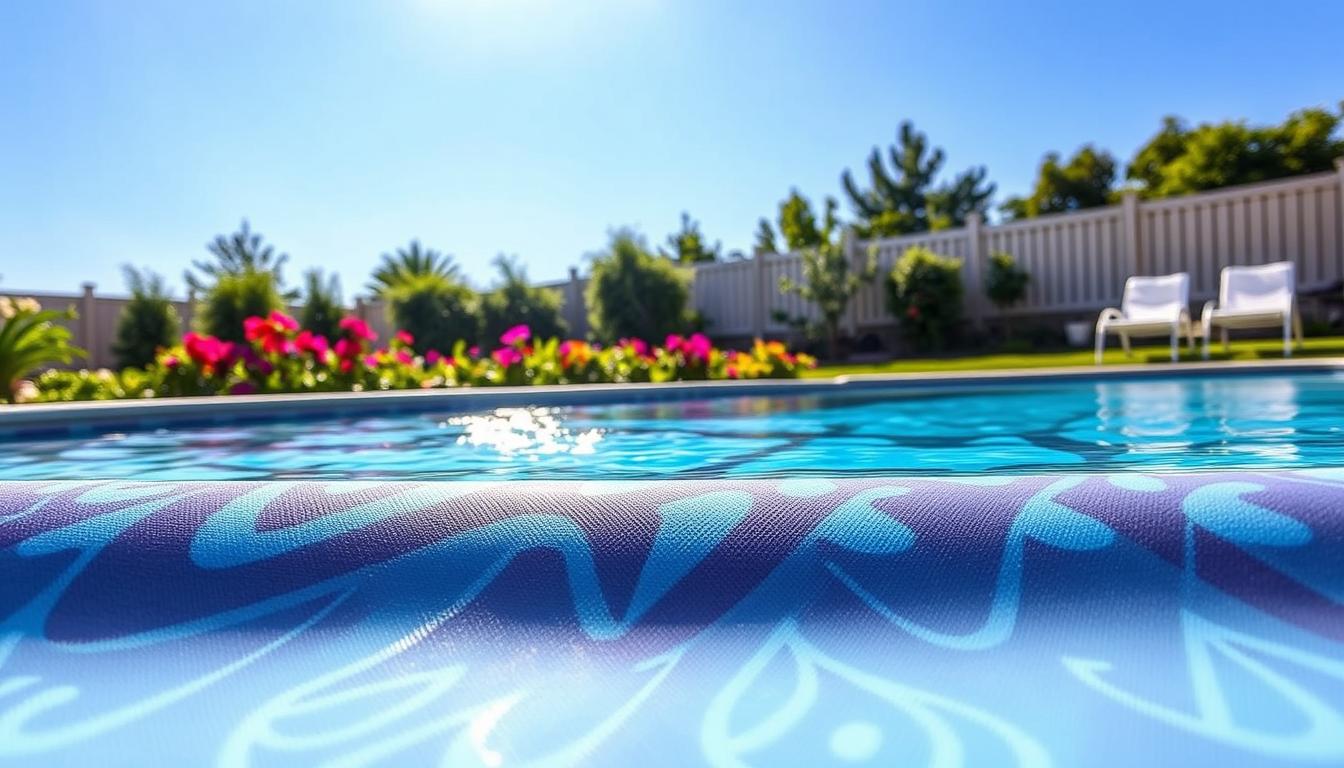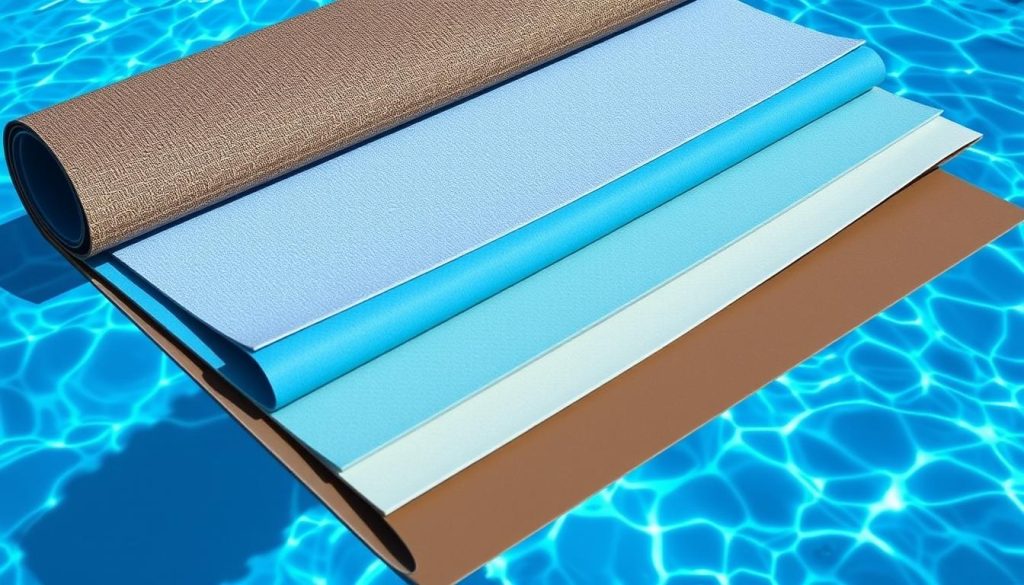
Choosing the right pool liner thickness is crucial for a long-lasting backyard oasis. Many options exist, from vinyl to heavy-duty materials. Understanding different pool liner materials and gauges ensures your pool stays pristine for years.
Vinyl pool liners come in various thicknesses: 20, 27, 28, or 30 mils. Thicker liners offer better durability and resist punctures from sharp objects. While pricier upfront, thicker liners can save money by reducing replacement frequency.
We’ll explore mil vs. gauge, embossed vs. non-embossed liners, and factors affecting longevity. This guide will help you pick the best pool liner thickness. You’ll create a perfect setting for summer fun and lasting memories.
Understanding Pool Liner Thickness and Measurements
Choosing the right pool liner requires understanding thickness and measurements. Liner thickness affects durability, longevity, and overall performance. Let’s explore vinyl liner thickness basics and measurement differences.
Vinyl Liner Thickness Basics
Pool liners typically range from 20-25 mil gauge for average pool owners. A mil equals one-thousandth of an inch, measuring liner thickness.
Take accurate measurements across your pool’s inside walls. This ensures a proper fit when selecting a liner.
Mil vs. Gauge: What’s the Difference?
Mil is the standard unit for pool liner thickness. Some manufacturers use gauge, which can vary between dealers.
Always ask for measurements in mils when replacing or installing a pool liner. This ensures you get the right thickness.
“A mil is 1/1000 of an inch, also called a ‘thou’ (as in a thousandth). About 39 mils equals 1 mm.”
Embossed vs. Non-Embossed Liners
Embossed liners have a textured surface with peaks and valleys. They feel softer or thicker to touch. Their thickness is measured by the highest peaks.
Non-embossed liners have a flat, even surface. They maintain consistent thickness throughout.
| Liner Type | Thickness | Texture |
|---|---|---|
| Embossed | Varies (measured by highest peaks) | Soft, textured feel |
| Non-Embossed | Consistent throughout | Flat, even surface |
Vinyl liners offer many customizable options for your pool’s shape and style. You can find patterns and tiles to complement your backyard oasis.
Factors Affecting Pool Liner Durability and Longevity
Several key factors influence the durability of vinyl pool liners. These include quality installation, water chemistry maintenance, and protection from damage. Understanding these elements can help extend your liner’s life and keep it looking great.
Proper Installation Techniques
Proper installation is crucial for pool liner durability. A well-installed liner will outlast a poorly installed one, regardless of thickness. Choose experienced professionals who follow best practices in pool liner installation.
Thicker vinyl liners, like 20 mil or 25 gauge, offer more protection. They resist punctures, tears, and UV damage better. While pricier, thicker liners safeguard your investment more effectively.
Maintaining Optimal Water Chemistry
Proper water chemistry is vital for your pool and liner health. Improper chemical balance is the main cause of liner issues. To prevent deterioration, maintain these optimal ranges for your pool water:
| Parameter | Optimal Range |
|---|---|
| pH Level | 7.2-7.8 |
| Chlorine | 1.0-3.0 ppm |
| Total Alkalinity | 80-120 ppm |
| Calcium Hardness | 200-400 ppm |
| Stabilizer (CYA) | 30-100 ppm |
Regular testing and adjusting of pool water chemistry helps prevent liner damage. Avoid overusing chlorine, as it can harm the liner. Focus on maintaining a clean, well-sanitized pool to reduce the need for high chlorine levels.
Protecting Your Liner from Punctures and Tears
Physical damage can greatly reduce your pool liner’s lifespan. To minimize risk, use toys designed for pools. Choose vinyl-safe vacuum and brush materials to prevent scratches or tears.
Install protective products like liner pads and ladder pads in high-traffic areas. Regularly inspect your pool liner for wear and tear. Patch or replace damaged portions as needed.
- Use toys designed specifically for pool use, as they are less likely to damage the vinyl liner.
- Choose vinyl pool vacuum and brush materials carefully to prevent scratches or tears.
- Install protective products like liner pads, foam pool cove, and ladder pads to cushion high-traffic areas.
- Regularly inspect your pool liner for signs of wear and tear, and patch or replace damaged portions as needed.
Using a pool cover protects your liner from UV exposure. This prevents fading and brittleness over time. Proper winterization, including balanced chemicals and secure covers, safeguards your liner during colder months.
The standard lifespan for a vinyl liner is 5–9 years regardless of thickness. A correctly installed 20-mil liner will last longer than a poorly installed 27-mil liner.
Focus on proper installation, water chemistry, and damage protection to extend your liner’s life. These steps will help you enjoy a beautiful, durable pool for years to come.
Comparing the Costs of Different Pool Liner Thicknesses
Pool liner thickness affects the cost of your swimming pool. Vinyl liners are cheaper than fiberglass and concrete pools. However, thicker liners can increase the overall cost.
The average pool liner replacement costs $2,900. Factors like pool size and liner type influence this price. Overlap liners for above-ground pools cost $100-$500. Beaded liners, more durable, range from $500-$1,000.

Upgrading to a thicker vinyl pool liner can increase costs by hundreds of dollars. More material means higher prices. Each thickness upgrade can add $200-$400 to the total cost.
| Pool Size | Liner Replacement Cost Range |
|---|---|
| 12 x 24 feet | $1,300 – $2,300 |
| 14 x 28 feet | $1,700 – $2,600 |
| 16 x 32 feet | $2,100 – $3,000 |
| 18 x 36 feet | $2,400 – $3,700 |
| 20 x 40 feet | $3,000 – $5,500 |
Non-embossed liners cost less than embossed ones of the same thickness. This is because embossed liners use more material. A 28/20 embossed liner costs less than a 28/28 non-embossed liner.
Despite long warranties, the average vinyl liner lasts anywhere between 8 and 10 years. Replacement costs are usually between $3,500 and $5,000.
Pool liner replacement involves material and labor costs. Above-ground pool liner replacement costs $500-$1,800, with labor ranging from $200-$900. Inground pool liner replacement is pricier, costing $1,500-$3,000, with labor from $1,000-$2,500.
Your budget, pool size, and desired durability determine the right liner thickness. Thicker liners cost more upfront but are more durable. They resist tears and punctures better, potentially saving money long-term.
What Gauge Pool Liner is Best for Your Swimming Pool?
Choosing the right pool liner thickness involves considering durability, cost, and aesthetic appeal. Vinyl pool liners come in 20 to 30 mils thickness. Thicker liners are more resistant to punctures from dog claws or tree branches.
The pattern and design of your pool liner should be your main focus. Liners often fail due to ink fading or material dry rotting above the waterline. Thicker material doesn’t solve these issues.
Upgrading to a 27 or 28 mil liner can offer better puncture protection. It may allow for patching instead of full replacement. However, prioritize the liner pattern that you like most.
Choose a thicker material if it’s free. But don’t pay extra for thickness at the expense of your preferred pattern. Your pool liner’s look should be more important than its thickness.
Consider the differences between vinyl liner, concrete, and fiberglass pools. Think about cost, installation, customization, replacement, resale value, and maintenance. Fiberglass pools are durable and resist scratches from sharp objects.
Concrete pools offer durability and aesthetic appeal. However, they may have higher maintenance costs than fiberglass pools. Weigh these factors carefully to choose the best pool liner for you.







